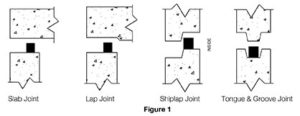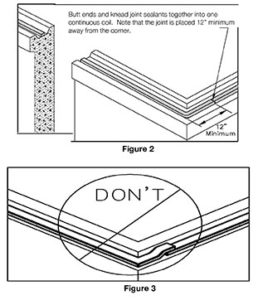Fuel/Oil Containment
Recommended Specifications
To properly understand the best method of sealing the joint of a precast concrete product, some of the myths and misconceptions about sealants must be discussed. Laboratory testing and engineering analysis has lead to some “rules of thumb” when selecting and applying precast concrete joint sealants in a compression joint – in this case for fuel containment, compression joints.
Definitions
Compression Joint: A surface between two mating concrete sections where force is to be applied to compress the sealant material.
Preformed sealant: A composition of rubbers manufactured to meet a specific standard and formed into a shape for application in a compression joint.
Hydrostatic: Hydrostatic pressure is the pressure exerted by a fluid at equilibrium due to the force of gravity.
Annular Space: The intentional void space within a joint between the parallel angled surfaces.
Tongue and Groove: A keyway, having two offsets with mating sections.
Ship Lap/Single Offset: Two planes offset by an angled surface.
Slab Joint: The flat joint has no offset. It is simply the mating of two flat surfaces.
Lap Joint: Any of various joints between two members in which an end or section of one is partly cut away to be overlapped by an end or section of the other, often so that flush surfaces result.
Concrete Mid-Seam Structure: This structure is cast as two parts and joined with a seam in the middle. This structure has also been termed a two-piece tank.
Concrete Top-Seam Structure: This structure is cast as two parts. Top Seam structures have a lid, which sets on top of the casting.
Butyl: A hydrocarbon radical.
Sealant Selection
Materials
Sealants are typically designed to resist hydrostatic forces at a precast concrete joint to provide a watertight seal. The American Society of Testing and Materials (ASTM) specification C990 defines the required composition and performance testing requirements for preformed butyl sealants. Sealants that meet this standard will provide a reasonable level of assurance for performance in watertight requirements. Butyl rubber content and hydrocarbon content are synonymous terms.
Shape
A traditional misconception of preformed sealants is that wider is better. That is a myth. Preformed butyl rubber sealants work best at higher rates of compression. As the sealant is compressed, the resistance force for further compression increases as a function of the percentage of compression. Time and temperature, as well as the sealant composition, will affect this rate. For instance, the force (psi) to compress the sealant the initial 10% to 50% may range from 2psi to 4psi. But as the sealant reaches 75% compression, the resistance force is about 8psi, and at 85% compression, this reaches a force of about 12psi. As the sealant is compressed, the sealing gasket increases in width as it becomes thinner. This width increases the surface area of the applied force. As the area reaches a point of equilibrium with the designed resistance force of the sealant, compression will stop. The analogy best used is the use of snow shoes. As the area of the applied force is increased, the force per square inch is reduced; thus enabling a person to walk on top of the snow.
Size / Volume
How much sealant is needed to seal the joint? The answer is as varied as the types and sizes of concrete castings being produced. There is no magic answer. Too little sealant may cause the joint to leak; too much sealant will be difficult to compress. The size of sealant required is determined by the volume needed to fill enough of the void to eliminate the possibility that a hydrostatic force will “push” the sealant. A minimum gasket width in the joint of 2″ is common.
Sealant manufacturers will specify the minimum amount of compression that is necessary to assure a watertight seal. The quick answer is a minimum of 50% compression. However, a gap that is too large will not provide an adequate seal, even if the sealant is compressed by 50% of its height. ConSeal recommends a maximum joint gap of 3/8”. This recommendation is good to follow for all joints of precast components. The important thing to remember is that the tighter the joint is, the better the seal is, and the less chance there is of a leak.
A “rule of thumb” for finding the width after compression is to use this formula: (TF/P)/100, where TF=Total force applied in pounds, P=the length of the entire perimeter in feet. Example: 15,000 pounds of force is applied to a rectangular casting 10′ x 5′. The perimeter is 30′. Calculate: (15,000/30)/100=5. Therefore, the sealant will compress to a nominal width of about 5″.
Placement
Sealant placement is critical in providing the best, watertight joint. The preferred practice is to place precast joint sealants where the concrete touches the tightest. Precast joint sealants require placement in or near the annular space.
Adhesion
The adhesion of the sealant to the concrete affects the hydrostatic resistance. Water can pass by sealant through the concrete by absorption if the joint surface is not properly prepared. This will result in wetness in or near the joint, opposite of the side of the joint where water is present. Sealant will adhere to a clean, dense, well-cured concrete surface. Use one of ConSeal’s primers to improve adhesion to the substrate.
SEALING OPTION
Fuel containment structures are available in a variety of sizes and shapes. Sealing these units watertight is of utmost importance. ConSeal demonstrates the general sealing placement of the four typical joint designs.

Depicted in Figure 1 is a general placement for precast joint sealants in the four most common joint configurations. ConSeal products used: CS-440. When applying ConSeal precast joint sealant to a fuel containment structure, preparing the substrate is critical. Clean the upper and lower joint surface with a stiff bristle brush. Remove any dirt, debris, flashing, or concrete high points, which could keep the joint from coming together. Priming the joint has proven to be an effective method for preparing the substrate and enhancing the bond of the sealant.
Apply ConSeal precast joint sealant a minimum 12” from a corner. Firmly press the ConSeal joint sealant onto the surface making sure care is taken to place the sealant in the area determined to be the best, (Consult ConSeal for details on determining the proper placement). Do not stretch the joint sealant.
When applying multiple rolls of ConSeal , make sure to butt the ends of each individual roll together and knead to form a continuous coil. See Figure 2. Make sure to remove the protective plastic film. Do not overlap the sealant, Figure 3.

Disclaimer: This publication is to assist users to understand the proper use of ConSeal’s products. Contact ConSeal’s technical staff for practices and procedures that meet your specific requirement. Concrete Sealants, Inc. does not warranty any improper use of its products.
How can conseal help you today?
Are you looking for specific information, need to talk to someone, or want to schedule a lunch & learn? We can help! Click any of the links below.
